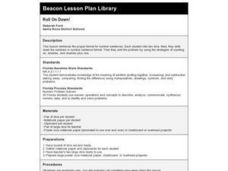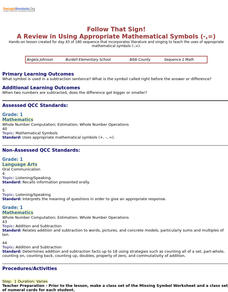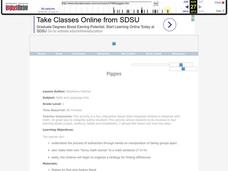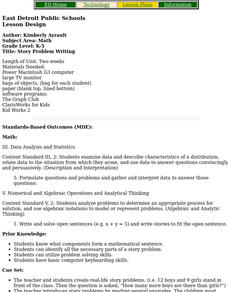Curated OER
Five Little Frogs
Students use music to study concepts in math. In this music math lesson, students sing songs, read books, and learn counting skills in frog themed activities.
Curated OER
Calc-You-Late Magnitudes
First graders are introduced and practice using a calculator. Individually, they enter and complete simple addition and subtraction problems. After the answer is displayed, they identify the place value for ones, tens, and hundreds...
Curated OER
Spin a Ten
In this addition and subtraction worksheet, 1st graders, working with a partner, spin a paperclip with a pencil to add and subtract units of 10 in 4 bingo cards. Students try to be the first player to get three totals in a row.
Curated OER
Why Mastery of Math Facts is Important
Discover why young mathematicians should master their math facts and use this strategy to motivate their proficiency.
Edline
Adding and Subtracting Integers
When should you use a number line to add and subtract integers, and when should you use absolute values? Complete a set of worksheets designed to reinforce adding and subtracting integers with both standard problems and word problems....
Curated OER
Scoot for Money
Students rotate through a group of centers counting the coins that are in a cup placed at each spot. After completing the entire circuit, papers are graded as a whole class and each student gets to spend the money in their cup at a class...
Curated OER
Doughnut Race
Pupils will practice math facts in this fast-paced and fun "Doughnut Race." This fun activity has learners practice their math facts in a face paced game environment. It can be adapted to all mathematical operations by using a poster...
Curated OER
Rockin Review
First graders practice math facts by matching a written fact with a math fact card.
Curated OER
Cubes, Sums and a Little Fun
First graders, with partners, create and solve math problems using number and unifix cubes.
Curated OER
Roll On Down!
Young scholars create number sentences by rolling two dice. Each student rolls the dice and writes down the numbers in number sentence format. Then they add the problem by using the strategies of counting on and doubles.
Curated OER
Place Value Popsicles
Students play a place value game using popsicle sticks and dice. They investigate units and tens.
Curated OER
Fact Families
Students explore about fact families. Before students begin doing word problems, they complete an activity . Students explore what a fact family is. A fact family is a set of math problems that use the same three numbers.
Curated OER
Calculating Cats
First graders are introduced to calculators. They complete a variety of math problems using calculators and identify basic parts on a calculator.
Curated OER
Follow That Sign! A Review in Using Appropriate Mathematical Symbols
Kids gain a deeper understanding of mathematical symbols, by playing an interactive game using flash cards. They complete an attached Missing Symbols Worksheet, flash card and an assessment are also included.
Curated OER
A Penny for Your Thoughts
Students collect pennies to donate to Kiwanis International for their international effort to buy salt for children's bone development. They calculate the amount of money donated, calculate how many children will receive salt, and write...
Curated OER
Fact-O!
Students practice math facts as they play a game of chance and skill. They correctly create and calculate mathematical equations, using the numbers rolled on three dice, and earn points for marking adjacent numbers on the game sheet.
Curated OER
Combining and Breaking Apart Numbers
First graders read Imogene's Antlers by David Small the create pipe cleaner antlers. Using these as a tool students combine and create number sentences. They continue to work through the framework of a software program.
Curated OER
Triangles and Things
Young learners listen to the story book The Greedy Triangle as the teacher introduces new polygon shapes. They use geometric stencils to trace a quadrilateral, a pentagon, a hexagon, and an octogon onto a foldable notepad. They identify...
Curated OER
Jelly Belly: What a Wonderful "Bean"!
Students explore how jelly beans are produced. They discuss the origins of the jelly bean and view a video about how jelly beans are prepared, tested, shaped, finished, and shipped and estimate the amount of jelly beans in a jar and sort...
Curated OER
The Grouchy Ladybug
Pupils complete a Cirlce Map about time. They recall times during the grouchy ladybugs travels, and add dots on ladybugs using turn-around facts. Pupils correctly sequence the events of The Grouchy Ladybug. Students compose new...
Curated OER
Piggies
First graders listen to the book, Piggies, and act out the events of the story with premade puffball pigs.
Curated OER
How Many More on a Graph?
First graders identify a number that is one more or one less than a number up to one hundred and identify a mystery number. They also create a class graph that illustrates how many children are in each family, and answer questions about...
Curated OER
Story Problem Writing
Students write story problems which can only be solved with the application of multiplication facts. They write an extra fact that isn't needed to solve. When their partners do the problems, they must cross out the fact that they do need.

























